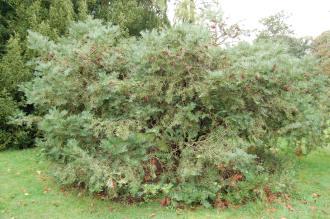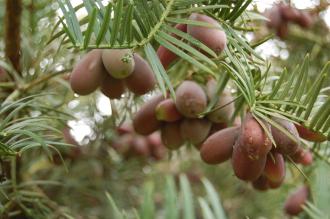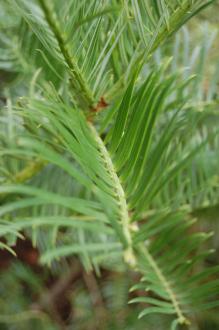
Cephalotaxus fortunei (20/10/2012, Kew Gardens, London)
Position: Full sun to shade
Flowering period: Spring
Soil: Moist, well drained
Eventual Height: 6m
Eventual Spread: 6m
Hardiness: 7a – 9b
Family: Cephalotaxaceae
Cephalotaxus fortunei is a slow growing, evergreen large shrub or small tree, usually multi stemmed with a rounded crown. Its glossy dark green leaves are in the form of needles with sharp tips, these are arranged horizontally and are up to 15cm long. This plant is dioecious and wind pollinated. Its fruit appear on the male plant and are up to 25mm long. These are arils, appearing blue, ripening to a purple brown color after two years, these are not edible.

Cephalotaxus fortunei Fruit (20/10/2012, Kew Gardens, London)
Cephalotaxus fortunei, commonly known as Chinese Plum Yew, Plumb Yew or Chinese Cowtail Pine, is native to Central and south west China. In its native habitat it grows in woodlands. It was introduced into the UK in 1848.
The etymological root of the binomial name Cephalotaxus is derived from the Latin cephalo meaning ‘ palm tree’ and the genus taxus, i.e. a Yew with the fruit of the palm. Fortunei is derived from the name of Robert Fortune, the Scottish botanist and traveler best known for introducing tea plants from China to India, back in the 19th century.

Cephalotaxus fortunei Leaf (20/10/2012, Kew Gardens, London)
The landscape architect may find Cephalotaxus fortunei useful as an unusual specimen shrub. It is also suitable for ornamental woodland planting schemes.
Ecologically, Cephalotaxus fortunei the fruit of this tree are attractive to some birds and mammals.
Cephalotaxus fortunei prefers moist, fertile, well-drained soils. It tolerates most pH of soil.
Cephalotaxus fortunei requires little maintenance.

